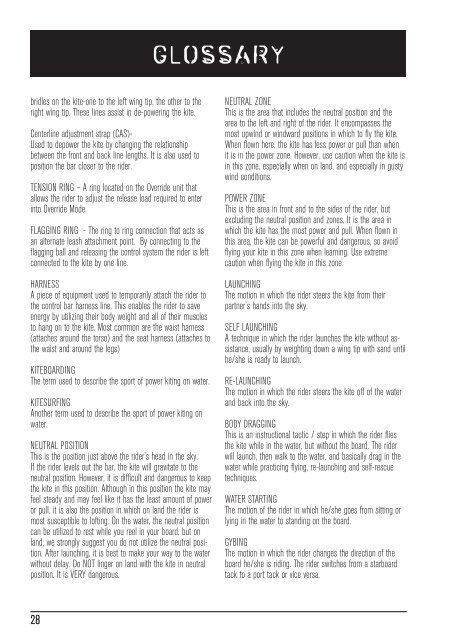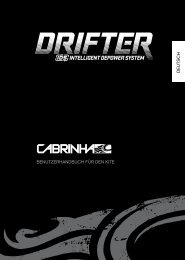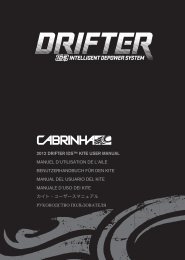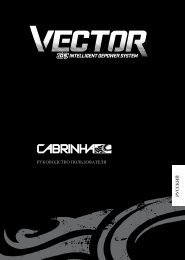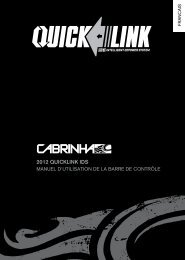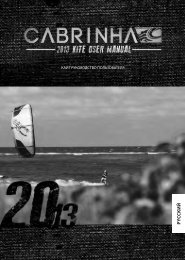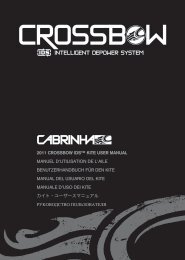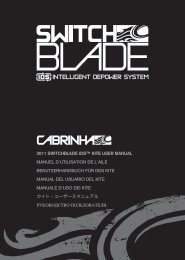SWITCHBLADE 2 - Cabrinha
SWITCHBLADE 2 - Cabrinha
SWITCHBLADE 2 - Cabrinha
Create successful ePaper yourself
Turn your PDF publications into a flip-book with our unique Google optimized e-Paper software.
GLOSSARY<br />
bridles on the kite-one to the left wing tip, the other to the<br />
right wing tip. These lines assist in de-powering the kite.<br />
Centerline adjustment strap (CAS)-<br />
Used to depower the kite by changing the relationship<br />
between the front and back line lengths. It is also used to<br />
position the bar closer to the rider.<br />
TENSION RING – A ring located on the Override unit that<br />
allows the rider to adjust the release load required to enter<br />
into Override Mode.<br />
FLAGGING RING - The ring to ring connection that acts as<br />
an alternate leash attachment point. By connecting to the<br />
flagging ball and releasing the control system the rider is left<br />
connected to the kite by one line.<br />
HARNESS<br />
A piece of equipment used to temporarily attach the rider to<br />
the control bar harness line. This enables the rider to save<br />
energy by utilizing their body weight and all of their muscles<br />
to hang on to the kite. Most common are the waist harness<br />
(attaches around the torso) and the seat harness (attaches to<br />
the waist and around the legs)<br />
KITEBOARDING<br />
The term used to describe the sport of power kiting on water.<br />
KITESURFING<br />
Another term used to describe the sport of power kiting on<br />
water.<br />
NEUTRAL POSITION<br />
This is the position just above the rider’s head in the sky.<br />
If the rider levels out the bar, the kite will gravitate to the<br />
neutral position. However, it is difficult and dangerous to keep<br />
the kite in this position. Although in this position the kite may<br />
feel steady and may feel like it has the least amount of power<br />
or pull, it is also the position in which on land the rider is<br />
most susceptible to lofting. On the water, the neutral position<br />
can be utilized to rest while you reel in your board, but on<br />
land, we strongly suggest you do not utilize the neutral position.<br />
After launching, it is best to make your way to the water<br />
without delay. Do NOT linger on land with the kite in neutral<br />
position. It is VERY dangerous.<br />
NEUTRAL ZONE<br />
This is the area that includes the neutral position and the<br />
area to the left and right of the rider. It encompasses the<br />
most upwind or windward positions in which to fly the kite.<br />
When flown here, the kite has less power or pull than when<br />
it is in the power zone. However, use caution when the kite is<br />
in this zone, especially when on land, and especially in gusty<br />
wind conditions.<br />
POWER ZONE<br />
This is the area in front and to the sides of the rider, but<br />
excluding the neutral position and zones. It is the area in<br />
which the kite has the most power and pull. When flown in<br />
this area, the kite can be powerful and dangerous, so avoid<br />
flying your kite in this zone when learning. Use extreme<br />
caution when flying the kite in this zone.<br />
LAUNCHING<br />
The motion in which the rider steers the kite from their<br />
partner’s hands into the sky.<br />
SELF LAUNCHING<br />
A technique in which the rider launches the kite without assistance,<br />
usually by weighting down a wing tip with sand until<br />
he/she is ready to launch.<br />
RE-LAUNCHING<br />
The motion in which the rider steers the kite off of the water<br />
and back into the sky.<br />
BODY DRAGGING<br />
This is an instructional tactic / step in which the rider flies<br />
the kite while in the water, but without the board. The rider<br />
will launch, then walk to the water, and basically drag in the<br />
water while practicing flying, re-launching and self-rescue<br />
techniques.<br />
WATER STARTING<br />
The motion of the rider in which he/she goes from sitting or<br />
lying in the water to standing on the board.<br />
GYBING<br />
The motion in which the rider changes the direction of the<br />
board he/she is riding. The rider switches from a starboard<br />
tack to a port tack or vice versa.<br />
28<br />
CK07SwitchbladeUserManual.indd 28<br />
8/10/06 3:41:03 AM


